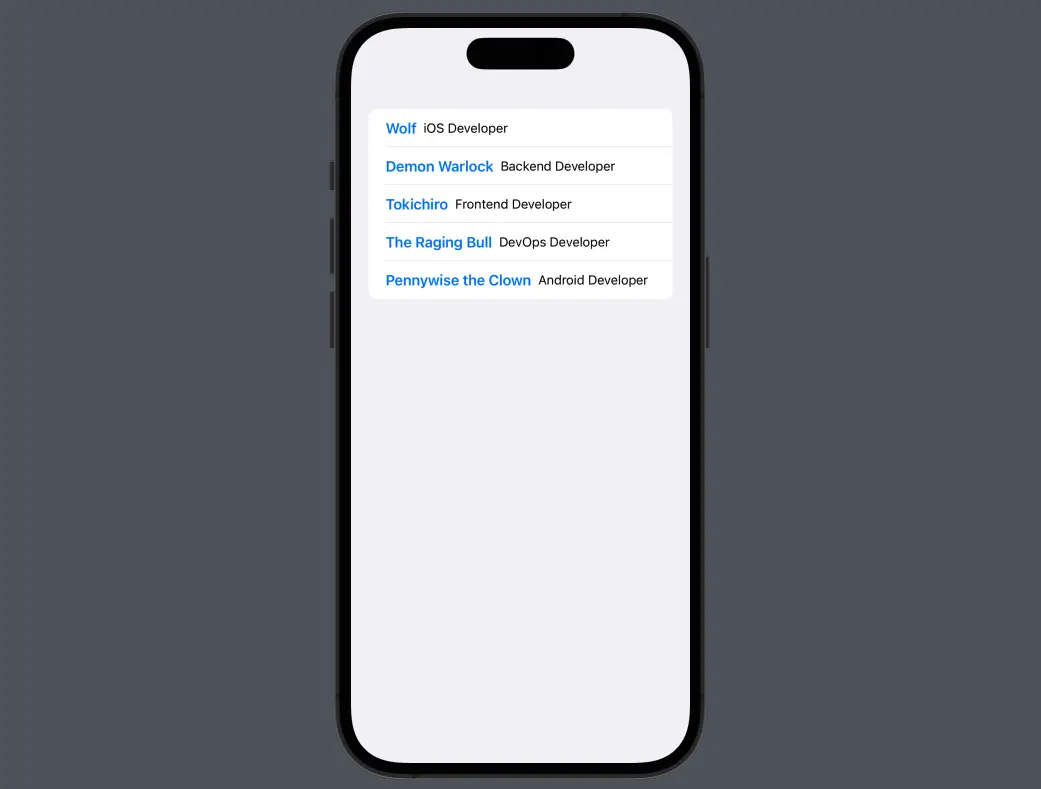This practical article will walk you through a couple of different ways to render an array of dictionaries in a List in SwiftUI. I assume you already have some basic understanding of SwiftUI, so I won’t waste your time by explaining what it is or rambling about the history of that Apple’s user interface toolkit. It’s better to write some code and make seeable things.
Using a ForEach loop and the subscript syntax (simple)
You can use a ForEach loop to iterate over an array of dictionaries and create a row for each dictionary. You need to make sure each dictionary has a unique identifier or use the .self key path as the id parameter.
The values of a dictionary can be accessed with the subscript syntax. However, they are optional values, thus we need to use the nil-coalescing operator like so:
Text(item["name"] ?? "")Example screenshot:

The complete code:
//
// ListExample.swift
// Examples
//
// Created by Goodman on 13/05/2023.
//
import SwiftUI
// Assume you have an array of dictionaries like this
let items = [
["name": "Item 1", "description": "This is some description of item 1"],
["name": "Item 2", "description": "This is some description of item 2"],
["name": "Item 3", "description": "This is some description of item 3"],
["name": "Item 4", "description": "This is some description of item 4"],
["name": "Item 5", "description": "This is some description of item 5"],
]
struct ListExample: View {
var body: some View {
// You can use a ForEach loop to render each dictionary in a List
List {
ForEach(items, id: \.self) { item in
VStack (alignment: .leading) {
// use the subscript syntax to access the values of each ditionary
Text(item["name"] ?? "No name").bold().font(.title)
Text((item["description"] ?? "Unknown")).foregroundColor(.gray)
}
}
}
}
}
struct ListExample_Previews: PreviewProvider {
static var previews: some View {
ListExample()
}
}See also: Access and Update Values in a Swift Dictionary.
Creating a custom struct for data modeling (recommended)
If you’re working on a serious project, you should model your data with structs (unfortunately, this requires a little extra work).
Example screenshot:

Complete code:
//
// ListExample.swift
// Examples
//
// Created by Goodman on 13/05/2023.
//
import SwiftUI
// An array of dictionaries
let data = [
["name": "Wolf", "job": "iOS Developer"],
["name": "Demon Warlock", "job": "Backend Developer"],
["name": "Tokichiro", "job": "Frontend Developer"],
["name": "The Raging Bull", "job": "DevOps Developer"],
["name": "Pennywise the Clown", "job": "Android Developer"],
]
// Create a struct that conforms to Decodable and Identifiable
struct Person: Decodable, Identifiable {
var id = UUID()
let name: String
let job: String
}
struct ListExample: View {
// Convert the data into an array of struct instances
let people = data.map {Person(name: $0["name"] ?? "Missing", job: $0["job"] ?? "Unknown")}
var body: some View {
// Implement the List
List(people) { person in
HStack {
Text(person.name).font(.headline).foregroundColor(.blue)
Text(person.job).font(.subheadline)
}
}
}
}
struct ListExample_Previews: PreviewProvider {
static var previews: some View {
ListExample()
}
}There is more than one way to turn an array of dictionaries into an array of structs in Swift. In the example above, I used the map() method. However, you can choose another approach if you like.




